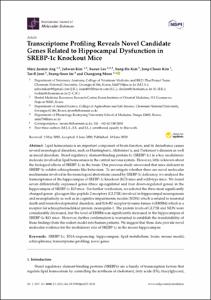Transcriptome Profiling Reveals Novel Candidate Genes Related to Hippocampal Dysfunction in SREBP-1c Knockout Mice
- Keimyung Author(s)
- Im, Seung Soon
- Department
- Dept. of Physiology (생리학)
- Journal Title
- International Journal of Molecular Sciences
- Issued Date
- 2020
- Volume
- 21
- Issue
- 11
- Keyword
- SREBP-1c; RNA-sequencing; hippocampus; lipid metabolism; brain; mouse model; schizophrenia; transcriptome profiling; novel genes
- Abstract
- Lipid homeostasis is an important component of brain function, and its disturbance causes several neurological disorders, such as Huntington's, Alzheimer's, and Parkinson's diseases as well as mood disorders. Sterol regulatory element-binding protein-1c (SREBP-1c) is a key modulatory molecule involved in lipid homeostasis in the central nervous system. However, little is known about the biological effects of SREBP-1c in the brain. Our previous study uncovered that mice deficient in SREBP-1c exhibit schizophrenia-like behaviors. To investigate whether there are novel molecular mechanisms involved in the neurological aberrations caused by SREBP-1c deficiency, we analyzed the transcriptomes of the hippocampus of SREBP-1c knockout (KO) mice and wild-type mice. We found seven differentially expressed genes (three up-regulated and four down-regulated genes) in the hippocampus of SREBP-1c KO mice. For further verification, we selected the three most significantly changed genes: glucagon-like peptide 2 receptors (GLP2R) involved in hippocampal neurogenesis and neuroplasticity as well as in cognitive impairments; necdin (NDN) which is related to neuronal death and neurodevelopmental disorders; and Erb-B2 receptor tyrosine kinase 4 (ERBB4) which is a receptor for schizophrenia-linked protein, neuregulin-1. The protein levels of GLP2R and NDN were considerably decreased, but the level of ERBB4 was significantly increased in the hippocampus of SREBP-1c KO mice. However, further confirmation is warranted to establish the translatability of these findings from this rodent model into human patients. We suggest that these data provide novel molecular evidence for the modulatory role of SREBP-1c in the mouse hippocampus.
- Keimyung Author(s)(Kor)
- 임승순
- Publisher
- School of Medicine (의과대학)
- Citation
- Mary Jasmin Ang et al. (2020). Transcriptome Profiling Reveals Novel Candidate Genes Related to Hippocampal Dysfunction in SREBP-1c Knockout Mice. International Journal of Molecular Sciences, 21(11), 4131. doi: 10.3390/ijms21114131
- Type
- Article
- ISSN
- 1422-0067
- Source
- https://www.mdpi.com/1422-0067/21/11/4131
- Appears in Collections:
- 1. School of Medicine (의과대학) > Dept. of Physiology (생리학)
- 파일 목록
-
-
Download
 oak-2020-0357.pdf
기타 데이터 / 1.8 MB / Adobe PDF
oak-2020-0357.pdf
기타 데이터 / 1.8 MB / Adobe PDF
-
Items in Repository are protected by copyright, with all rights reserved, unless otherwise indicated.